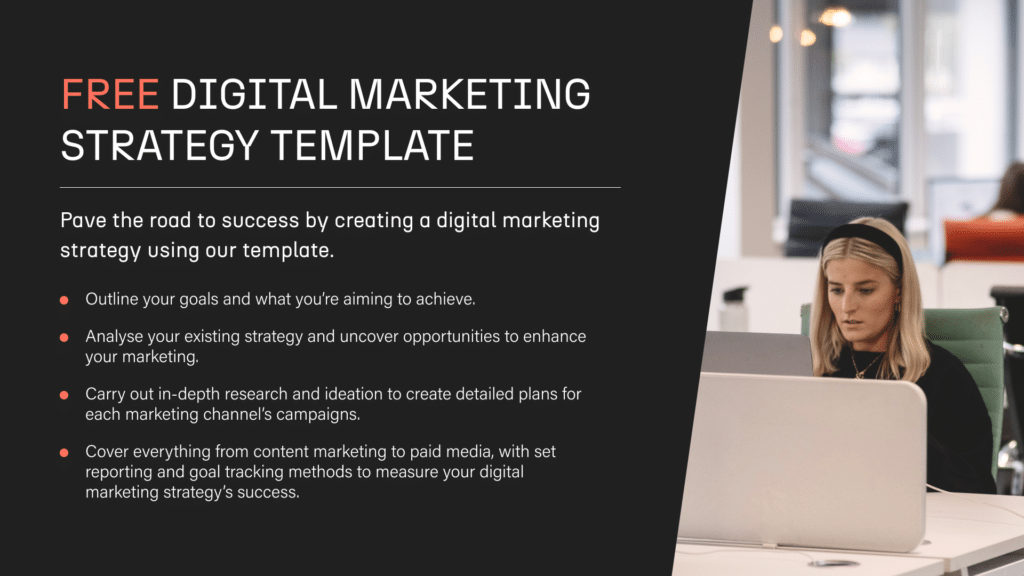How to Present Your Marketing Strategy: Tips and Examples [With Template]
You’ve got your marketing strategy sorted, it’s packed with top-notch ways to increase your digital performance and you’re ready to put it into practice. But before you do that, there’s the not-so-small matter of presenting it to either your team, senior staff or the key clients who’ve asked for your expertise in the first place.
But if you’ve never done it before, or you’re a little out of practice, you might be a bit nervous about delivering one. The good news is, with the proper prep, you’ll be able to present your work like a pro.
Below, we’ll run through some effective marketing strategy presentation tips and what your strategy should include. We’ve also thrown in our digital marketing strategy template for you to download too!
Quick Navigation
- What does a marketing strategy include?
- A marketing strategy framework in more detail
- Marketing strategy presentation tips
- Download our digital marketing strategy template
What does a marketing strategy include?
A marketing strategy includes the plan, actions and marketing-related goals that’ll all go towards achieving a company’s wider business goals. It’ll also detail the channels you’ll use to deliver your plans through, whether it’s through social media, emails, print or video content (just to provide a few examples).
Part of your marketing strategy will also involve analysing the activities of your closest competitors to see what they’re doing. Competitor analysis lets you what the competition is up to, so you can add to your own activities, avoid the things that aren’t working for them, stay on top of best practices and look for the gaps that you can then fill with your own activity.
A marketing strategy framework in more detail
Let’s fine tune things a big further. Here’s what your strategy should look like when it comes to its structure…
Overview
What will this strategy include? What are your reasons for creating it? How far into the future will it span? What do you want to achieve? Answering questions like these provides an overarching view that gives the whole strategy a focus and logic to follow.
Goals
Goals give your strategy an engine. Without them, it’ll struggle to go anywhere. Additionally, you’ll need to make them measurable, achievable and timely. They should also be linked back to the key goals of the business too – so if your business’ main goal is to increase sales by a certain amount, your strategy’s goals and activity should pursue this too.
Channel details
In this section, you’ll evaluate the marketing channels that you’re currently using (and their effectiveness), any opportunities you’re aiming to take advantage of, how your target audiences will differ across channels, and the activity you’ll carry out to appeal to them in the most effective ways possible.
Budgets
If you’ve got larger campaigns or Paid Media activity planned, then you’ll want to put a fair bit of money behind either of them. Knowing how much budget to allocate can be a bit of a challenge – and even more of a challenge to stick to – so it’s important to know how to go about doing both. Luckily, we’ve covered what you need to know about marketing budgets here.
Reporting and goal tracking
You won’t know how well your strategy is going without tracking your goals and reporting on its progress. And by doing so, you’ll know what needs adjusting – if you need to tinker with a few things. In this section, make it clear how you aim to report on the successful aspects of your campaign and keep track of your data – as well the metrics and KPIs you’ll be using to measure these successes.

Marketing strategy presentation tips
Now it’s time to deliver your marketing strategy presentation. Use these top tips to make sure everything goes smoothly on the day, whoever your audience is.
Tailor things to your audience
As with any time instance of public speaking, you’ll have to consider the audience you’re talking to. It’s no different when you’re delivering a marketing strategy presentation. And who your audience will more than likely affect both the content and the delivery – so consider who this might be.
If you’re delivering to your team, then a light-hearted approach could work. As could more technical language. But if you’re delivering to senior staff, you may want to tone down the jargon and opt for simple concepts that everyone in attendance can understand.
Tell a story
Constructing a narrative around the information in your presentation is a great way to get your audience emotionally onboard with what you’re saying – a powerful approach if your audience actually needs convincing to go along with your strategy.
You might choose to start with an ice breaker or a hook that relates to the problem your strategy aims to solve. Including personal anecdotes that have a connection to the content are also a strong approach too, allowing your audience to see your human side before you get to the main points themselves.
Keep your slides brief
There’s a chance that clients and senior staff have to attend more than one presentation a day. As a result, their attention might start to wane, especially if your slides are crammed with too much information.
The content on your slides should be brief. Stick to the main points, and use these as a jumping off point that you’ll expand on verbally with the help of your notes. High-quality imagery, statistics and interactive elements like quizzes and polls also serve to make information more easily digestible – and hold your audience’s attention further still.
Be consistent with your visuals
Speaking of the visual aspects of your presentation, you’ll want to make sure everything is uniform and consistent. Of course, the content will be the most important element, but don’t forget about the packaging that it’s all wrapped up in either.
Make sure you’re consistent with brand colours, slide designs and fonts across your presentation. The attention to detail you show here demonstrates credibility and legitimacy, and lets your audience familiarise themselves with your brand too.
Project confidence in your delivery
Not the easiest part of a presentation, we know. But confidence has a huge role to play in your presentation. Confident delivery shows you’re an authority on the topic at hand – which helps to hold the audience’s attention further.
When delivering your audience, be sure to make eye contact with your audience, stand up straight and look up from your notes. Non-verbal actions like this help to create a rapport with your audience, who’ll notice when you’re doing the opposite – and that’s the kind of attention you don’t want to receive.
Download our digital marketing strategy template

We hope you’ve found the above insights helpful! Not made a start on your marketing strategy just yet? Give our digital marketing strategy template a download and get everything we talked about earlier off the ground…
Know what you want to do but don’t have the time or resource to do them? Let our digital strategy team get to work crafting and implementing an action plan that’ll achieve your goals, whatever your digital aims are. Head to the homepage or give us a call on 0345 459 0558 today!



